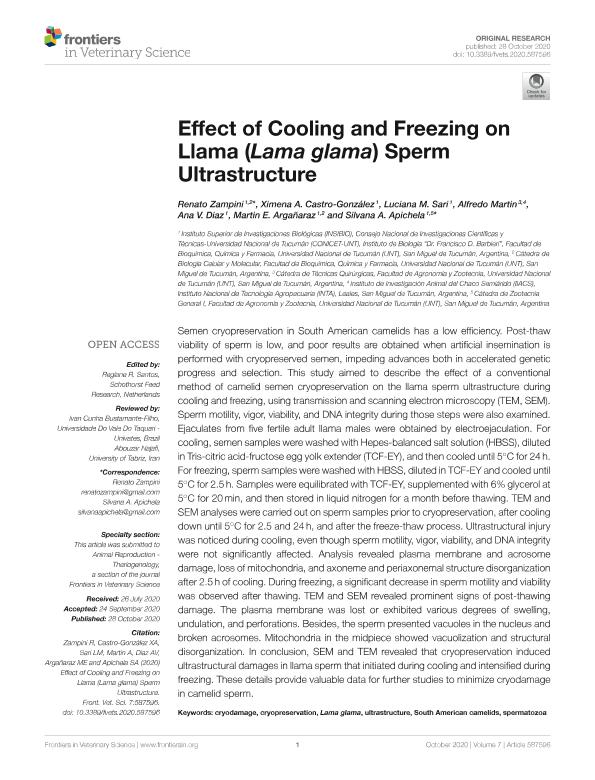Artículo
Effect of Cooling and Freezing on Llama (Lama glama) Sperm Ultrastructure
Zampini, Renato ; Castro Gonzalez, Ximena Aixa
; Castro Gonzalez, Ximena Aixa ; Sari, Luciana María
; Sari, Luciana María ; Martin, Alfredo; Diaz, Ana Victoria
; Martin, Alfredo; Diaz, Ana Victoria ; Argañaraz, Martin Eduardo
; Argañaraz, Martin Eduardo ; Apichela, Silvana Andrea
; Apichela, Silvana Andrea
 ; Castro Gonzalez, Ximena Aixa
; Castro Gonzalez, Ximena Aixa ; Sari, Luciana María
; Sari, Luciana María ; Martin, Alfredo; Diaz, Ana Victoria
; Martin, Alfredo; Diaz, Ana Victoria ; Argañaraz, Martin Eduardo
; Argañaraz, Martin Eduardo ; Apichela, Silvana Andrea
; Apichela, Silvana Andrea
Fecha de publicación:
10/2020
Editorial:
Frontiers Media
Revista:
Frontiers in Veterinary Science
ISSN:
2297-1769
Idioma:
Inglés
Tipo de recurso:
Artículo publicado
Clasificación temática:
Resumen
Semen cryopreservation in South American camelids has a low efficiency. Post-thaw viability of sperm is low, and poor results are obtained when artificial insemination is performed with cryopreserved semen, impeding advances both in accelerated genetic progress and selection. This study aimed to describe the effect of a conventional method of camelid semen cryopreservation on the llama sperm ultrastructure during cooling and freezing, using transmission and scanning electron microscopy (TEM, SEM). Sperm motility, vigor, viability, and DNA integrity during those steps were also examined. Ejaculates from five fertile adult llama males were obtained by electroejaculation. For cooling, semen samples were washed with Hepes-balanced salt solution (HBSS), diluted in Tris-citric acid-fructose egg yolk extender (TCF-EY), and then cooled until 5°C for 24 h. For freezing, sperm samples were washed with HBSS, diluted in TCF-EY and cooled until 5°C for 2.5 h. Samples were equilibrated with TCF-EY, supplemented with 6% glycerol at 5°C for 20 min, and then stored in liquid nitrogen for a month before thawing. TEM and SEM analyses were carried out on sperm samples prior to cryopreservation, after cooling down until 5°C for 2.5 and 24 h, and after the freeze-thaw process. Ultrastructural injury was noticed during cooling, even though sperm motility, vigor, viability, and DNA integrity were not significantly affected. Analysis revealed plasma membrane and acrosome damage, loss of mitochondria, and axoneme and periaxonemal structure disorganization after 2.5 h of cooling. During freezing, a significant decrease in sperm motility and viability was observed after thawing. TEM and SEM revealed prominent signs of post-thawing damage. The plasma membrane was lost or exhibited various degrees of swelling, undulation, and perforations. Besides, the sperm presented vacuoles in the nucleus and broken acrosomes. Mitochondria in the midpiece showed vacuolization and structural disorganization. In conclusion, SEM and TEM revealed that cryopreservation induced ultrastructural damages in llama sperm that initiated during cooling and intensified during freezing. These details provide valuable data for further studies to minimize cryodamage in camelid sperm.
Archivos asociados
Licencia
Identificadores
Colecciones
Articulos(INSIBIO)
Articulos de INST.SUP.DE INVEST.BIOLOGICAS
Articulos de INST.SUP.DE INVEST.BIOLOGICAS
Citación
Zampini, Renato; Castro Gonzalez, Ximena Aixa; Sari, Luciana María; Martin, Alfredo; Diaz, Ana Victoria; et al.; Effect of Cooling and Freezing on Llama (Lama glama) Sperm Ultrastructure; Frontiers Media; Frontiers in Veterinary Science; 7; 10-2020; 1-14
Compartir
Altmétricas



